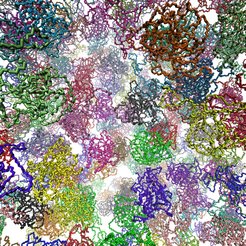Modeling of Folding Equilibria in the Interior of the Cell

Based on existing interaction models, which are being used for Brownian dynamics simulations of complex protein solutions with up to 1000 proteins, we are developing in our group simulation methods which allow us to take into account the internal degrees of freedom of the proteins. Due to the use of Monte Carlo sampling, we have to pass on the ability to study dynamical processes in detail. However, our simulations allow us to study equilibria, for example between folded and unfolded states, as well as to analyze the influence of the environment on those. Here, we focus on the influence of specific and unspecific interactions between the molecules in the solution, which we can modify by tampering with the different terms of the interactions potential.
Our simulations accompany the experimental work in the group of Jun.-Prof. Dr. Simon Ebbinghaus at the Ruhr-University Bochum, which studies protein and polymer folding in vitro as well as in vivo.
The goal of this project is to understand the influence of the special environment of a protein in the interior of a cell, which is characterized by high concentrations of proteins and other biopolymers. A current scientific question is, whether the differences between experimental observations at high dilution in vitro and more recent studies in complex biological environments such as the interior of a cell, which have become feasible only recently, can be explained purely by volume exclusion effects, so-called “molecular crowding”, or if attractive interactions between the proteins need to be taken into account as well.
